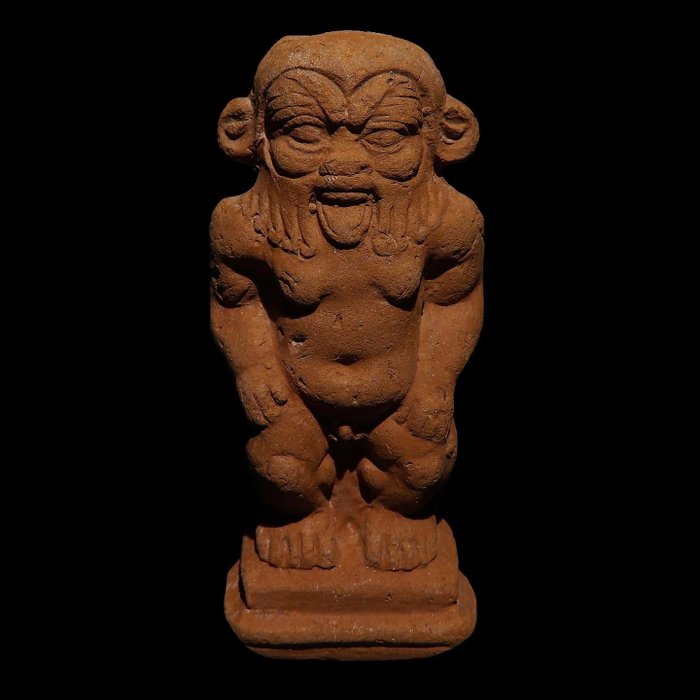
Égypte ancienne Bronze Sculpture du Dieu Bes. 9,5 cm H. Période ptolémaïque ou romaine ; 332 avant JC-1er siècle après JC.
Nº 84340203

Nº 84340203

God Bes
Egypt, Roman Period, 30 BC – 1st AD.
Terracotta.
9 cm H.
Condition: Very good see photos.
Provenance
Old private collection, London, formed during 1960 – 1970.
Private collection, United Kingdom. Acquired in the London art market.
The figurine, representing the Egyptian deity Bes, is mold-made.
The grotesque-like face with the tongue sticking out, thick daggy beard, lion-like ears and eyes wide open under thick wrinkles and brows. Contrary to the early depictions the already human like features are typical for the Hellenistic influence in the Greek-Roman period. Bes had an apotropaic function in households and temples. He protected against dangerous animals in the desert, such as snakes and scorpions. At the same time he was also worshiped as the god for conception and birth. He was considered as the protector for pregnant women and newborns. His depictions were usually found in bowers and on headboards (especially wedding beds).
There are several opinions concerning the origins of Bes, and the meaning of his name. His name may be related to verbs meaning “to initiate”, “to emerge” or “to protect”. But is has also been suggested that the word indicates a prematurely born child or foetus (which was enveloped in a lion’s skin), making the god Bes the personification of such a prematurely born child, which also helps to explain why he is especially engaged in protecting mother and child.
Bes, a minor god of ancient Egypt, represented as a dwarf with large head, goggle eyes, protruding tongue, bowlegs, bushy tail, and usually a crown of feathers. The name Bes is now used to designate a group of deities of similar appearance with a wide variety of ancient names. The god’s figure was that of a grotesque mountebank and was intended to inspire joy or drive away pain and sorrow, his hideousness being perhaps supposed to scare away evil spirits. He was portrayed on mirrors, ointment vases, and other personal articles. He was associated with music and with childbirth and was represented in the “birth houses” devoted to the cult of the child god. Contrary to the usual rule of representation, Bes was commonly shown full-faced rather than in profile, since full-faced figures were marginal to the normal, ordered world.
The seller guarantees that he acquired this piece according to all national and international laws related to the ownership of cultural property. Provenance statement seen by Catawiki.
#ExclusiveJurassicAntiquity
Comment acheter sur Catawiki ?
1. Découvrez des objets d’exception
2. Faites la meilleure offre
3. Effectuez un paiement sécurisé